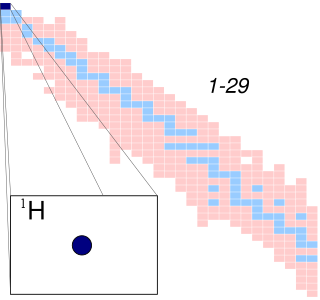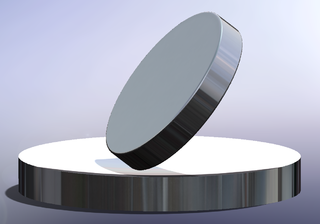 | |
| Type | Top |
|---|---|

A tippe top is a kind of top that when spun, will spontaneously invert itself to spin on its narrow stem. It was invented by a German nurse, Helene Sperl in 1898. [1]
 | |
| Type | Top |
|---|---|

A tippe top is a kind of top that when spun, will spontaneously invert itself to spin on its narrow stem. It was invented by a German nurse, Helene Sperl in 1898. [1]
A tippe top usually has a body shaped like a truncated sphere, with a short narrow stem attached perpendicular to the center of the flat circular surface of truncation. The stem may be used as a handle to pick up the top, and is also used to spin the top into motion.
When a tippe top is spun at a high angular velocity, its stem slowly tilts downwards more and more until it suddenly lifts the body of the spinning top off the ground, with the stem now pointing downward. Eventually, as the top's spinning rate slows, it loses stability and eventually topples over, like an ordinary top.
At first glance the top's inversion may mistakenly seem to be a situation where the object spontaneously gains overall energy. This is because the inversion of the top raises the object's center of mass, which means the potential energy has in fact increased. What causes the inversion (and the increase in potential energy) is a torque due to surface friction, which also decreases the kinetic energy of the top, so the total energy does not actually increase. [2]
Once the top is spinning on its stem, it does not spin in the opposite direction to which its spin was initiated. For example, if the top was spun clockwise, as soon as it is on its stem, it will be spinning clockwise viewed from above. This constant spin direction is due to conservation of angular momentum.
It is usually assumed that the speed of the tippe top at the point of contact with the plane is zero (i.e. there is no slippage). However, as indicated by P. Contensou, [3] this assumption does not lead to a correct physical description of the top's motion. The unusual behavior of the top can be fully described by considering dry friction forces at the contact point. [4] [5]

Condensed matter physics is the field of physics that deals with the macroscopic and microscopic physical properties of matter, especially the solid and liquid phases that arise from electromagnetic forces between atoms and electrons. More generally, the subject deals with condensed phases of matter: systems of many constituents with strong interactions among them. More exotic condensed phases include the superconducting phase exhibited by certain materials at extremely low cryogenic temperatures, the ferromagnetic and antiferromagnetic phases of spins on crystal lattices of atoms, the Bose–Einstein condensates found in ultracold atomic systems, and liquid crystals. Condensed matter physicists seek to understand the behavior of these phases by experiments to measure various material properties, and by applying the physical laws of quantum mechanics, electromagnetism, statistical mechanics, and other physics theories to develop mathematical models and predict the properties of extremely large groups of atoms.

The electron is a subatomic particle with a negative one elementary electric charge. Electrons belong to the first generation of the lepton particle family, and are generally thought to be elementary particles because they have no known components or substructure. The electron's mass is approximately 1/1836 that of the proton. Quantum mechanical properties of the electron include an intrinsic angular momentum (spin) of a half-integer value, expressed in units of the reduced Planck constant, ħ. Being fermions, no two electrons can occupy the same quantum state, per the Pauli exclusion principle. Like all elementary particles, electrons exhibit properties of both particles and waves: They can collide with other particles and can be diffracted like light. The wave properties of electrons are easier to observe with experiments than those of other particles like neutrons and protons because electrons have a lower mass and hence a longer de Broglie wavelength for a given energy.

Friction is the force resisting the relative motion of solid surfaces, fluid layers, and material elements sliding against each other. Types of friction include dry, fluid, lubricated, skin, and internal.

Ferromagnetism is a property of certain materials that results in a significant, observable magnetic permeability, and in many cases, a significant magnetic coercivity, allowing the material to form a permanent magnet. Ferromagnetic materials are noticeably attracted to a magnet, which is a consequence of their substantial magnetic permeability.

A hydrogen atom is an atom of the chemical element hydrogen. The electrically neutral atom contains a single positively charged proton and a single negatively charged electron bound to the nucleus by the Coulomb force. Atomic hydrogen constitutes about 75% of the baryonic mass of the universe.
A photon is an elementary particle that is a quantum of the electromagnetic field, including electromagnetic radiation such as light and radio waves, and the force carrier for the electromagnetic force. Photons are massless particles that always move at the speed of light when in vacuum. The photon belongs to the class of boson particles.

Spontaneous symmetry breaking is a spontaneous process of symmetry breaking, by which a physical system in a symmetric state spontaneously ends up in an asymmetric state. In particular, it can describe systems where the equations of motion or the Lagrangian obey symmetries, but the lowest-energy vacuum solutions do not exhibit that same symmetry. When the system goes to one of those vacuum solutions, the symmetry is broken for perturbations around that vacuum even though the entire Lagrangian retains that symmetry.

A spinning top, or simply a top, is a toy with a squat body and a sharp point at the bottom, designed to be spun on its vertical axis, balancing on the tip due to the gyroscopic effect.

Euler's Disk, invented between 1987 and 1990 by Joseph Bendik, is a trademarked scientific educational toy. It is used to illustrate and study the dynamic system of a spinning and rolling disk on a flat or curved surface. It has been the subject of several scientific papers.
In physics, a parity transformation is the flip in the sign of one spatial coordinate. In three dimensions, it can also refer to the simultaneous flip in the sign of all three spatial coordinates :

The nuclear force is a force that acts between hadrons, most commonly observed between protons and neutrons of atoms. Neutrons and protons, both nucleons, are affected by the nuclear force almost identically. Since protons have charge +1 e, they experience an electric force that tends to push them apart, but at short range the attractive nuclear force is strong enough to overcome the electrostatic force. The nuclear force binds nucleons into atomic nuclei.
The Breit equation, or Dirac–Coulomb–Breit equation, is a relativistic wave equation derived by Gregory Breit in 1929 based on the Dirac equation, which formally describes two or more massive spin-1/2 particles interacting electromagnetically to the first order in perturbation theory. It accounts for magnetic interactions and retardation effects to the order of 1/c2. When other quantum electrodynamic effects are negligible, this equation has been shown to give results in good agreement with experiment. It was originally derived from the Darwin Lagrangian but later vindicated by the Wheeler–Feynman absorber theory and eventually quantum electrodynamics.

A rattleback is a semi-ellipsoidal top which will rotate on its axis in a preferred direction. If spun in the opposite direction, it becomes unstable, "rattles" to a stop and reverses its spin to the preferred direction.
In physics, superradiance is the radiation enhancement effects in several contexts including quantum mechanics, astrophysics and relativity.
In atomic, molecular, and optical physics and quantum chemistry, the molecular Hamiltonian is the Hamiltonian operator representing the energy of the electrons and nuclei in a molecule. This operator and the associated Schrödinger equation play a central role in computational chemistry and physics for computing properties of molecules and aggregates of molecules, such as thermal conductivity, specific heat, electrical conductivity, optical, and magnetic properties, and reactivity.
In rigid-body dynamics, the Painlevé paradox is the paradox that results from inconsistencies between the contact and Coulomb models of friction. It is named for former French prime minister and mathematician Paul Painlevé.

A Gyroscopic Exercise Tool is a specialized device used in physical therapy to improve wrist strength, promoting the development of palm, forearm, and finger muscles. It can also be used as a unique demonstration of some aspects of rotational dynamics. The device consists of a tennis ball-sized plastic or metal shell surrounding a free-spinning mass, with an inner heavy core, which can be spun by a short rip string. Once the gyroscope inside is going fast enough, the person holding the device can accelerate the spinning mass to high rotation rates by moving the wrist in a circular motion. The force enacted on the user increases as the speed of the inner gyroscope increases.

The light-front quantization of quantum field theories provides a useful alternative to ordinary equal-time quantization. In particular, it can lead to a relativistic description of bound systems in terms of quantum-mechanical wave functions. The quantization is based on the choice of light-front coordinates, where plays the role of time and the corresponding spatial coordinate is . Here, is the ordinary time, is one Cartesian coordinate, and is the speed of light. The other two Cartesian coordinates, and , are untouched and often called transverse or perpendicular, denoted by symbols of the type . The choice of the frame of reference where the time and -axis are defined can be left unspecified in an exactly soluble relativistic theory, but in practical calculations some choices may be more suitable than others.

The dihydrogen cation or hydrogen molecular ion is a cation with formula H+
2. It consists of two hydrogen nuclei (protons), each sharing a single electron. It is the simplest molecular ion.

The physics of a bouncing ball concerns the physical behaviour of bouncing balls, particularly its motion before, during, and after impact against the surface of another body. Several aspects of a bouncing ball's behaviour serve as an introduction to mechanics in high school or undergraduate level physics courses. However, the exact modelling of the behaviour is complex and of interest in sports engineering.